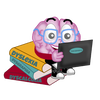Raising awareness for the struggles of individuals with math learning difficulties through recognizing and celebrating World Dyscalculia DayIn honor of World Dyscalculia Day, we would like to shed some light on what dyscalculia is. Over my 10 plus years working with learners with Dyslexia, Dysgraphia and Dyscalculia, I have found that many learners struggle with math and math anxiety, and they are not aware that dyscalculia is a thing! Dyscalculia is a learning difficulty directly related to math. To them, it is like trying to understand someone speaking a foreign language they haven’t learned. It causes undue stress, learning obstacles and lower self-esteem. Dyscalculia is a deficit in the brain’s ability to process number-related information. This means that the learner may have a difficult time with basic math skills such as addition, subtraction, memorizing multiplication tables, understanding the relationship with math concepts, struggling with sequencing, reading an analog clock, budgeting time, keeping on schedule, budgeting funds and many other aspects. When they get to high school Algebra is usually very challenging because it is arbitrary in nature, however, they can usually do geometry pretty successfully.
Learners that struggle due to dyscalculic need to be taught differently in order to succeed. Common core is not the most ideal way for them to be taught. Here are seven strategies for making math concepts from basic arithmetic to advanced algebra easier to understand and remember. 1. Use manipulatives when working out the problem. When learners are working on math problems it is ideal to have a visual aid available for them to understand it in real terms. Some examples of this are to use actual change and dollar bills when they are learning about money, cut a sandwich in halves or quarters for fractions, double a recipe is a great way to understand measurements and fractions. 2. Talk through the math problem. Talking through a problem in the form of a sentence can help with grasping a concept. Restating word problems in the learners’ own words can make a world of difference. 3. Draw the problem on paper. Drawing the problem is really helpful for visual learners to see that math is not so abstract after all. If the learner is confused you can draw it out for them to see or you can ask them to draw what they think the problem is stating. 4. Use graph paper. Lining up problems can be a real struggle for Dyscalculic learners. If the numbers start to slant, they can easily get confused as to what they wrote down and then become overwhelmed trying to figure out where they went wrong. Using graphic paper can help them to keep everything in place. 5. Break tasks down into small pieces. Complex problems or concepts can be extremely overwhelming for Dyscalculic learners. Separating a problem into its component parts and working through them one at a time can help students focus, see connections and avoid overload. 6. Use daily activities as an opportunity to teach math skills. I have found relating math with daily life activities can help dyscalculic learners make the most sense of math concepts. Teach them how to tell time when they want to do something and want to know how long it will take. Bake and cook with them and double or cut a recipe in half. Teach them fractions by having them save and tithe or donate a percentage of their allowance or birthday money. 7. Review often. This is the most important thing to remember! Dyscalculic learners struggle to retain information so it is imperative to review often! In order to keep your learners attention, it is ideal to practice math frequently for short periods of time and review concepts learned, often: every day, if possible. 3D Learning Experts does not require that our students have an official diagnosis. We have been helping students with math difficulties succeed for over 10 years and we help them succeed and gain confidence in themselves All of our learners start off with a placement assessment that helps us understand how they think and what they know and we use that information to set up a personalized program for your child’s unique needs. Our focus is on understanding, helping our learners develop and strengthen the connections needed to succeed in school. Sometimes learners with Dyscalculia or math struggles, fall into a negative rut that they just can’t pull themselves out of. We have helped some students work on just basic math skills and they are back on the horse learning alongside their classmates, others need to work with our specialized math tutors for a few years to work on developing their understanding of math, most importantly, they all leave 3D Learning Experts so much more capable than when they started. Take our short quiz to find out if 3D Learning Experts is a good fit for your child. Click here to learn more.
0 Comments
Your comment will be posted after it is approved.
Leave a Reply. |
LEXIA LEARNERS LOUNGE
AuthorJess Arce is a homeschool mom of four, a tutor for children & adults who struggle with Dyslexia & Dysgraphia and an all around entrepreneur. She is passionate about helping others understand dyslexia. |
